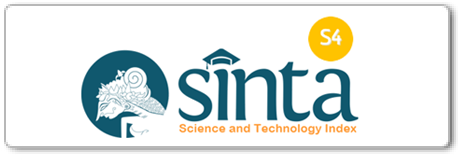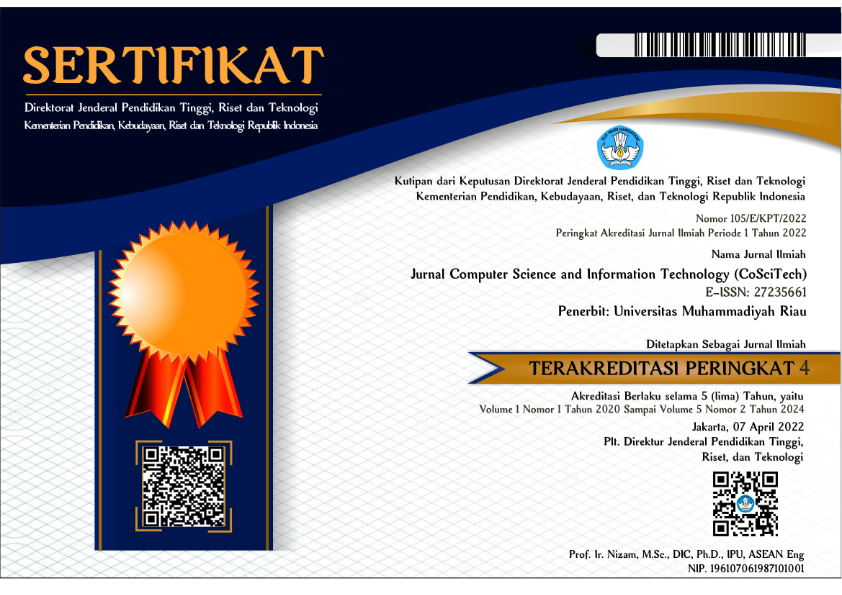Metode Multi Attribute Utility Theory (MAUT) Untuk Penilaian Kinerja Guru
DOI:
 https://doi.org/10.37859/coscitech.v4i3.5920
https://doi.org/10.37859/coscitech.v4i3.5920
Abstract
The performance assessment of teachers is a foundation or basis for the development decisions in terms of promotion and career of teachers in a madrasah or school. Currently, teacher performance assessment at Pondok Pesantren MTI Canduang is limited to teachers who are civil servants (PNS) or have obtained certification. In an effort to improve the quality of education, it is important to evaluate the performance of all teachers, including those who are not civil servants. The conventional method of assessment using paper-based evaluation sheets is considered inaccurate and inefficient due to the large number of teachers being assessed. Furthermore, there is no appropriate method for making decisions regarding teacher reward programs. Therefore, the purpose of this research is to apply the Multi Attribute Utility Theory (MAUT) method for teacher performance assessment. This method aims to provide a basis for decision-making in recommending teachers who deserve rewards in each assessment period. Based on the test results using the MAUT method with 40 teacher data and 12 defined assessment criteria, it was found that 3 data points for Tsanawiyah level had the highest value of 0.797 and the lowest value of 0.332, while 3 data points for Aliyah level had the highest value of 0.874 and the lowest value of 0.386. Thus, the research results can help the madrasah determine the best alternatives according to predefined criteria and weights. The resulting web-based application can facilitate the assessment process by making it easier, faster, and more accurate.
Downloads
References
[2] R. D. Kurniawati and I. Ahmad, “Sistem Pendukung Keputusan Penentuan Kelayakan Usaha Mikro Kecil Menengah Dengan Menggunakan Metode Profile Matching Pada Uptd Plut Kumkm Provinsi Lampung,” J. Teknol. dan Sist. Inf., vol. 2, no. 1, pp. 74–79, 2021, doi: https://doi.org/10.33365/jtsi.v2i1.610.
[3] K. Zong, Y. Yuan, C. E. Montenegro-Marin, and S. N. Kadry, “Or-Based Intelligent Decision Support System for E-Commerce,” J. Theor. Appl. Electron. Commer. Res., vol. 16, no. 4, pp. 1150–1164, Mar. 2021, doi: 10.3390/jtaer16040065.
[4] Y. Fatma, Januar Al Amien, and Riski Hakiki, “Sistem Pendukung Keputusan Penilaian Pegawai Di Klinik Bunda Medical Center (BMC) Dengan Menggunakan Metode Simple Additive Weighting (SAW),” J. CoSciTech (Computer Sci. Inf. Technol., vol. 2, no. 2, pp. 1–9, 2022, doi: 10.37859/coscitech.v2i2.2961.
[5] R. Wahyuni, S. Defit, and G. W. Nurcahyo, “The Multi Attribute Utility Theory (Death) Method In The Decision Of The Distributor Distributor Selection (Metode Multi Attribute Utility Theory (Maut) Dalam Keputusan Pemilihan Distributor Barang),” J. KomtekInfo, vol. 7, no. 2, pp. 84–100, 2020, doi: 10.35134/komtekinfo.v7i2.69.
[6] R. T. Aldisa, “Sistem Pendukung Keputusan Dengan Menerapkan Metode Multi- Attribute Utility Theory Pada Pemilihan Content Writer,” vol. 4, no. 2, pp. 0–7, 2023, doi: 10.47065/josyc.v4i2.2877.
[7] S. F. Pantatu and I. C. R. Drajana, “Sistem Pendukung Keputusan Penerima Bantuan UMKM Menggunakan Metode MAUT,” J. Nas. Komputasi dan Teknol. Inf., vol. 5, no. 2, pp. 317–325, 2022, doi: 10.32672/jnkti.v5i2.4207.
[8] Y. Setiawan and S. Budilaksono, “Sistem Pendukung Keputusan Pemilihan Mahasiswa Lulusan Terbaik Dengan Menggunakan Metode Multi Attribute Utility Theory (Maut) DiStmik Antar Bangsa,” Ikraith-Informatika, vol. 6, no. 2, pp. 12–20, 2022, doi: 10.37817/ikraith-informatika.v6i2.1566.
[9] I. N. Sanita, S. Defit, and G. W. Nurcahyo, “Sistem Pendukung Keputusan Menggunakan Metode Multi Attribute Utility Theory Untuk Pemilihan Layanan Digital,” J. CoSciTech (Computer Sci. Inf. Technol., vol. 4, no. 1, pp. 216–225, Apr. 2023, doi: 10.37859/coscitech.v4i1.4742.
[10] O. N. Silalahi, N. Yanti, L. Gaol, and J. Halim, “Sistem Pendukung Keputusan Menentukan Kualitas Pupuk Menggunakan Metode Maut,” vol. 2, pp. 394–402, 2023, doi: https://doi.org/10.53513/jursi.v2i3.6260.
[11] K. Suhada, A. Sadikin, I. K. Dewi, and F. Nugroho, “Penerapan Metode Multi-Attribute Utility Theory ( MAUT ) pada Pemilihan Broadcasting Terbaik,” vol. 7, no. April, pp. 641–649, 2023, doi: 10.30865/mib.v7i2.5937.
[12] L. Sitorus, A. Rikki, and J. Simanjuntak, “Penerapan Multi Attribute Utility Theory ( MAUT ) untuk Memberikan Kelayakan Sertifikasi Guru SD non PNS,” Citra Sains Teknol., vol. 1, pp. 104–109, 2022, doi: https://doi.org/10.2421/cisat.v1i2.55.
[13] D. A. Darmawin and R. S. Oetama, “Teacher Performance Evaluation Decision Support System Using Simple Additive Weighting: Case Study Mentari Intercultural School,” G-Tech J. Teknol. Terap., vol. 7, no. 2, pp. 554–562, Mar. 2023, doi: 10.33379/gtech.v7i2.2327.
[14] R. Anggraeni and A. Effane, “Peranan Guru dalam Manajemen Peserta Didik,” Karimah Tauhid, vol. 1, no. 14, pp. 234–239, 2022, [Online]. Available: https://ojs.unida.ac.id/karimahtauhid/article/view/7701
[15] H. M. Nur and N. Fatonah, “Paradigma Kompetensi Guru,” J. PGSD UNIGA, vol. 1, no. 1, pp. 12–16, 2022.
[16] N. S. Lubis and N. Anriani, “Implementasi Model Center for the Study of Evaluation-University of California in Los Angeles (CSE-UCLA) dalam Penilaian Kinerja Guru,” JIIP - J. Ilm. Ilmu Pendidik., vol. 6, no. 2, pp. 860–866, Feb. 2023, doi: 10.54371/jiip.v6i2.1663.
[17] B. Widiyanto, “Sistem Informasi Penilaian Kinerja Guru Pada SMA Negeri 1 Sumberejo,” vol. 3, no. November 2009, pp. 1–16, 2023.
[18] Muslimin, “Program penilaian kinerja guru dan uji kompetensi guru dalam meningkatkan prestasi kerja guru,” Indones. J. Educ. Manag. Adm. Rev., vol. 4, no. 1, pp. 197–204, 2020, [Online]. Available: https://jurnal.unigal.ac.id/index.php/ijemar/article/view/4384
[19] M. Munawir, A. Yasmin, and A. J. Wadud, “Memahami Penilaian Kinerja Guru,” J. Ilm. Profesi Pendidik., vol. 8, no. 1b, pp. 627–634, Apr. 2023, doi: 10.29303/jipp.v8i1b.1237.
[20] M. Fikri and A. Saifudin, “Sistem Pendukung Keputusan Untuk Menentukan Kelayakan Menjadi Guru Tetap Yayasan Menggunakan Metode Simple Additive Weighting ( Studi Kasus Yayasan Pendidikan Islam Assa Adah Tajurhalang ),” vol. 2, no. 2, pp. 531–538, 2023.
[21] M. Syahrizal, “Sistem Pendukung Keputusan Pemilihan Guru Terbaik Dengan Menerapkan Metode WASPAS Dan Pembobotan Menggunakan Metode ROC Pada Sekolah Menengah Pertama ( SMP ),” vol. 6, no. November, pp. 216–224, 2022, doi: 10.30865/komik.v6i1.5680.
[22] M. Assidiq, M. Sarjan, B. Basri, and N. Nasrullah, “Analisis Pemeringkatan Guru Berprestasi Dengan Sistem Penunjang Keputusan Menggunakan Metode Electre,” J. Nas. Komputasi dan Teknol. Inf., vol. 5, no. 3, pp. 342–351, Jun. 2022, doi: 10.32672/jnkti.v5i3.4273.
[23] E. Elviani, E. Haerani, E. P. Cynthia, F. Kurnia, and F. Syafria, “Sistem Pebdukung Keputusan Penilaian Kinerja Guru Menggunakan Metode Multi Attribute Utility Theory (MAUT),” JIPI (Jurnal Ilm. Penelit. dan Pembelajaran Inform., vol. 7, no. 3, pp. 993–1004, Sep. 2022, doi: 10.29100/jipi.v7i3.3149.
[24] M. I. Fikri, E. Haerani, I. Afrianty, and S. Ramadhani, “Sistem Pendukung Keputusan Penilaian Kinerja Guru Menggunakan Metode Multi Attribute Utility Theory (MAUT),” JURIKOM (Jurnal Ris. Komputer), vol. 9, no. 5, p. 1271, Oct. 2022, doi: 10.30865/jurikom.v9i5.4791.
[25] A. A. Shash, M. Al-Salti, A. Alshibani, and L. Hadidi, “Predicting Cost Contingency Using Analytical Hierarchy Process and Multi Attribute Utility Theory,” J. Eng. Proj. Prod. Manag., vol. 11, no. 3, pp. 228–242, 2021, doi: 10.2478/jeppm-2021-0022.
[26] Bambang Hardian Syahputra, Irianto Irianto, and Febri Dristyan, “Implementasi Metode Multi Attribute Utility Theory Pemberian Komisi Untuk Sales,” J. Comput. Sci. Technol., vol. 1, no. 1, pp. 01–09, 2023, doi: 10.59435/jocstec.v1i1.3.
[27] H. Sunandar and B. Nadeak, “Penerapan Metode MAUT Terhadap Perkembangan Metaverse Untuk Media Pembelajaran Daring Dengan Pembobotan ROC,” vol. 6, no. November, pp. 100–107, 2022, doi: 10.30865/komik.v6i1.5753.
[28] N. Rivaldy, D. Irmayanti, and M. Defriani, “Perancangan SPK Kelayakan Pinjaman Koperasi Karyawan Perum Jasa Tirta Karya Bhakti Raharja dengan Metode MAUT,” vol. 7, pp. 172–181, 2023, doi: http://dx.doi.org/10.30645/j-sakti.v7i1.581.














